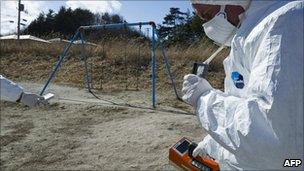Japan nuclear crisis: Pressure to widen evacuation zone
- Published

Environmental group Greenpeace has been monitoring levels of radioactivity at the village of Iitate
UN nuclear monitors have advised Japan to consider expanding the evacuation zone around the stricken reactors at the Fukushima Daiichi plant.
An exclusion zone with a radius of 20km (12 miles) is currently in place but the UN says safe radiation limits have been exceeded 40km away.
Meanwhile, radioactive iodine levels in seawater near the plant reached a new record - 4,385 times the legal limit.
It was the highest reading since the quake which hit the plant on 11 March.
Radioactive material may be leaking from the damaged plant continuously, the country's nuclear and industrial safety agency (Nisa) said.
Workers are continuing to try to stabilise four reactors by using water to cool fuel rods. They also face the problem of how to deal with highly radioactive run-off water that has accumulated in a tunnel.
The plant's operator, Tokyo Electric Power (Tepco), announced on Wednesday that the four stricken reactors would be decommissioned.
The huge quake, and the tsunami it triggered, are now known to have claimed more than 11,000 lives, with at least 16,000 people still reported missing by police, three weeks on.
'No immediate action'
The UN's nuclear watchdog (International Atomic Energy Agency, IAEA) found safe radiation limits had been exceeded at the village of Iitate, 40km north-west of the nuclear plant.
"The highest values were found in a relatively small area in the north-west from the Fukushima power plant and the first assessment indicates that one of the IAEA operational criteria for evacuation is exceeded in Iitate village," senior IAEA official Denis Flory said.
Iitate village mayor Norio Kanno admitted he was "very worried" about the IAEA warning, public broadcaster NHK reported on its website.
"But the government immediately informed us that there is no immediate harm to human health, so I was relieved," he added.
"Villagers have voiced concern, but the levels of radiation in the tap water and the air are declining. I will carefully monitor them before taking any actions."
Japan's top government spokesman, Chief Cabinet Secretary Yukio Edano, said on Thursday that the IAEA had advised the government to "carefully assess the situation on the basis of this report".
"I don't think that this is something of a nature which immediately requires such action," he told reporters.
"But the fact that the level of radiation is high in the soil is inevitably pointing to the possibility that the accumulation over the long term may affect human health.
"Therefore, we will continue monitoring the level of radiation with heightened vigilance and we intend to take action if necessary."
The BBC's Roland Buerk reports on how one town's sea wall helped protect its residents
The US and UK earlier advised their citizens in Japan to keep at least 80km from the plant.
The US is to send a 140-member radiation control team to assist Japanese authorities, Kyodo News agency quoted Japan's military chief, General Ryoichi Oriki, as saying.
French nuclear-reactor maker Areva was also offering help with containing contaminated water, reports from Japan said.
French President Nicolas Sarkozy arrived in Tokyo late on Thursday - the first foreign leader to visit since the earthquake.
He said France wanted to host a meeting of nuclear industry officials from the G20 group of nations in May, aimed at coming up with new global safety standards for the nuclear industry by the end of the year.
Prime Minister Naoto Kan, meanwhile, said he would review plans to build 14 more nuclear reactors by 2030, Kyodo news agency reported.